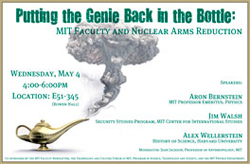
| Vol.
XXIII No.
4 March / April 2011 |
| contents |
| Printable Version |
Editorial
Protecting Education in America
The domestic news is filled with accounts of the Tea Party efforts in Wisconsin, Ohio, Indiana, and Florida to cut public investment in public services, often with a focus on K-12 public education. In the U.S. Congress, the same political forces are proposing severe cuts in the budgets of the National Science Foundation, National Institutes of Health, Department of Energy, Department of Education, and other federal agencies. These cuts will have significant negative effects not only on university-based research, but also on the fabric of higher education in the U.S. The initial impact will be born by reduced support for graduate students and for junior faculty, including our own students and colleagues. This will, of course, lower innovation in many areas of science and technology, and slow economic recovery.
Almost certainly the laying off of teachers and reducing investment in K-12 education in Wisconsin, Ohio, Florida, and other states will result in a reduction of high school graduates with a quality education. This will certainly be followed by efforts to reduce public investment in community colleges, state colleges, and state universities. One wing of the Tea Party forces will argue that since there are fewer high school graduates that can benefit from a college education, there is less need for institutions of higher education. The other wing will argue that a sector of higher education should be privatized and left to for-profit colleges who can provide education more “efficiently.”
Across the nation, the broader social impact of lowering the wages of public sector workers will be to lower the standard of living of a significant sector of the middle class in the U.S., and reduce the prospects of those living at the bottom to move up.
Though we may be temporarily insulated, it would be a deep error for MIT faculty to think of ourselves as outside of the struggles going on in Wisconsin and in Washington.
If public higher education in the U.S. is pushed back, all of us in higher education are at increased risk. If we sit back and let our public school system be undermined, we undermine the foundation of higher education in the nation – whether public or private.
Since MIT has no school or department of education, we lack a regular forum for discussion of general aspects of education in the U.S. As one small step to increase our ability to assess the impact of these events, the Faculty Newsletter will be holding a series of forums in the fall on the general subjects of Higher Education in the U.S. and on K-12 STEM (Science, Technology, Engineering, and Mathematics) Education in the U.S.
In the meantime we urge those of you who sit on Education or Public Policy Committees of your professional societies to press for an active response in defense of continuing public investment in higher education in general, in addition to the R&D component. One easy step is to make sure that forums on these issues are included in the programs of societies’ national and regional conferences. Both the National Education Association and the American Federation of Teachers will provide speakers addressing the issues.
* * * * * * * * * *
Putting the Genie Back in the Bottle:
MIT Faculty and Nuclear Arms Reduction
After the Manhattan Project and the bombing of Hiroshima and Nagasaki, the Cold War resulted in an enormous proliferation and deployment of nuclear weapons by the U.S., the
U.S.S.R., and their spread to other nations. In parallel, a robust movement against the development and testing of nuclear weapons also developed. Starting in 1945, many Manhattan Project alumni were active participants in the effort to make sure that these weapons would never be used again, and to warn the general public about their dangers. At MIT, this included Phil Morrison, Victor Weisskopf, Bernard Feld, Cyril Stanley Smith, and others. As the years went on and the problem only got larger, many more joined in. At MIT there were Henry Kendall, Salvador Luria, Jerome Wiesner, Kosta Tsipis, George Rathjens, Vera Kistiakowski, Aron Bernstein, Jonathan King, and others among the faculty, as well as many staff, students, and postdocs.
On March 4, 1968 a day of protest about the development of multi-warhead missiles (MIRV) was held at the Institute. This event initiated a worldwide movement and led to the formation of the Union of Concerned Scientists, later led by Henry Kendall. [Click here to see the “Founding Document: 1968 MIT Faculty Statement.”] The MIT campus aspects of this concern were aided by the Technology and Culture Forum.

(click on image to enlarge)
As a contribution to the MIT150 commemorations, the MIT Faculty Newsletter, the Technology and Culture Forum, the Program in Science, Technology, and Society, and the Department of Physics have organized a symposium [Wednesday, May 4, 4-6 pm] to honor and review this part of MIT history, and to focus on today’s no less urgent need to prevent nuclear war – the ultimate disaster for the Earth.
The current urgent concerns include nuclear reactor accidents, nuclear weapons proliferation, and to continue and accelerate the global reduction and eventual elimination of nuclear arsenals.
Editorial Subcommittee
| home this issue archives editorial board contact us faculty website |